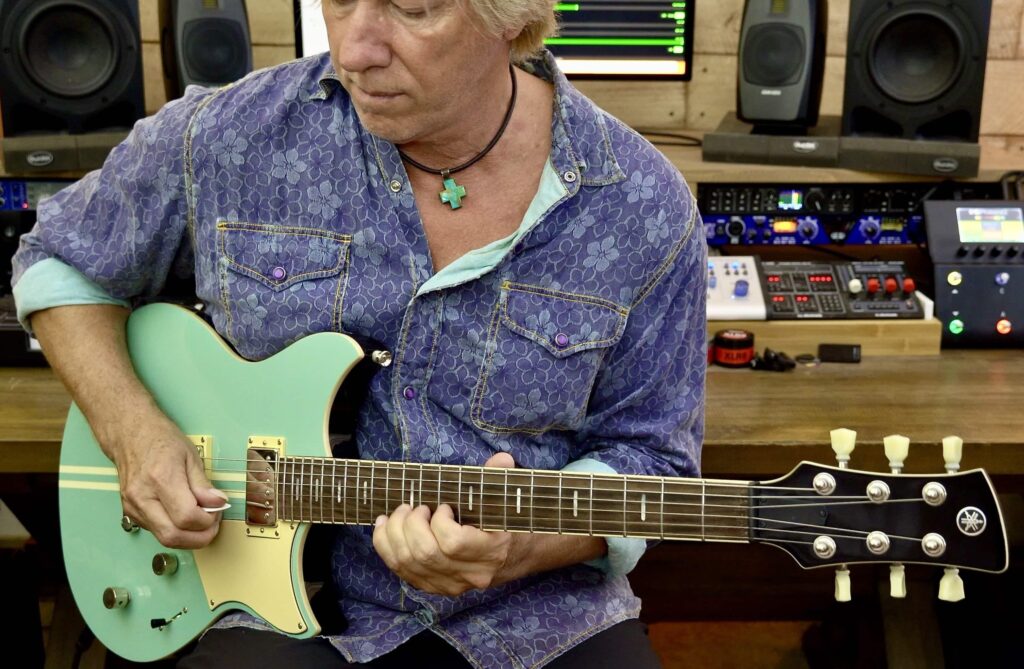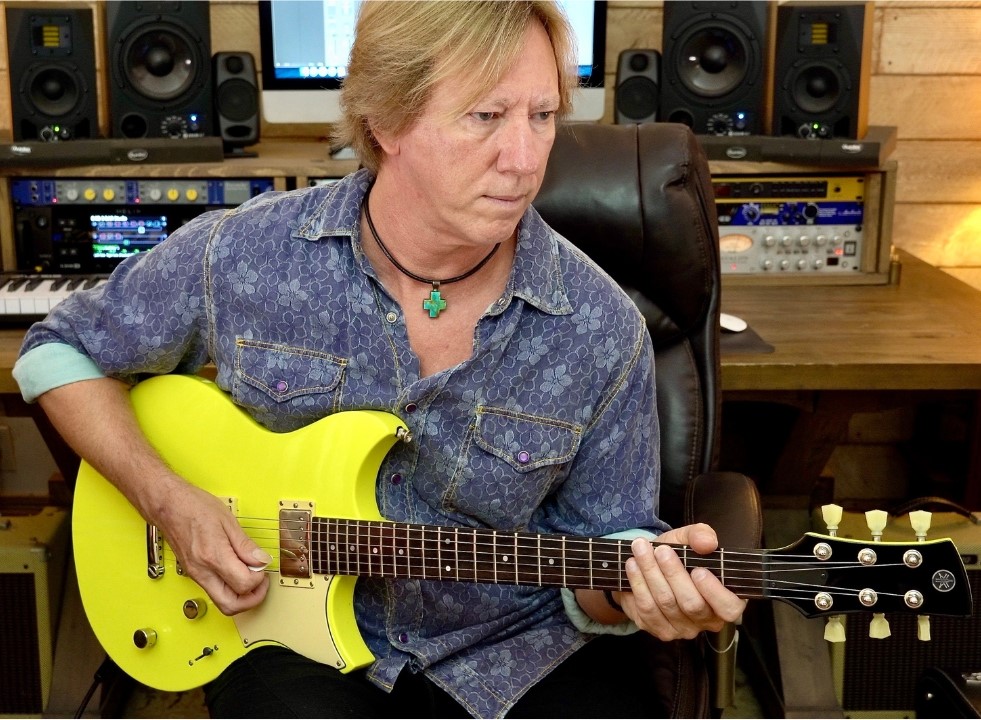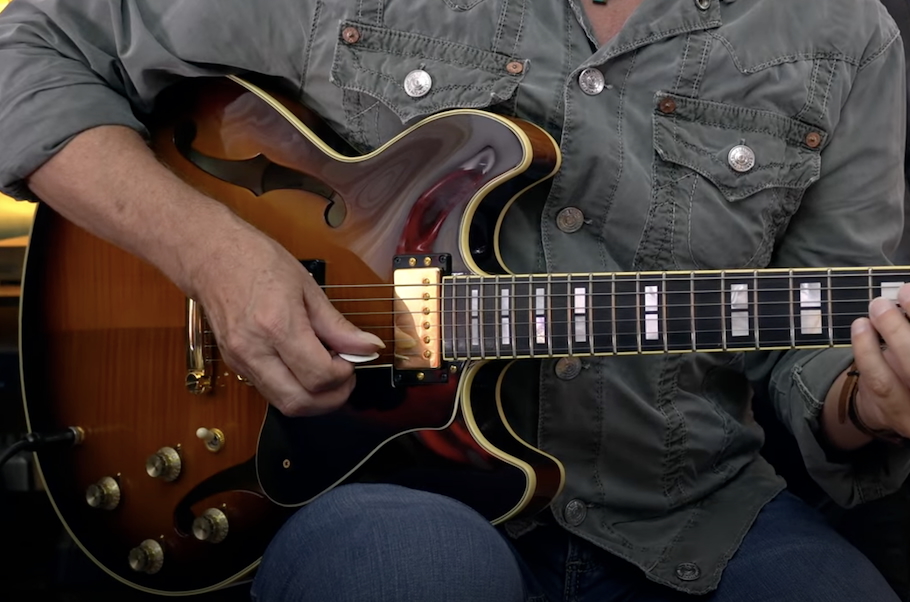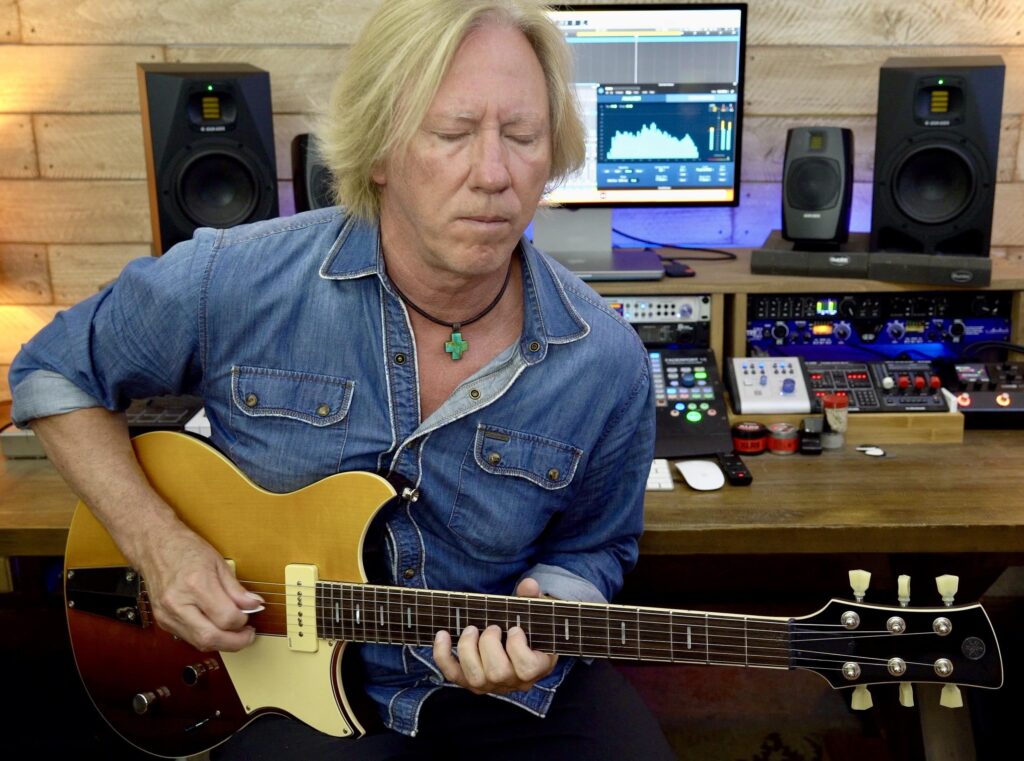Understanding the Circle of Fifths and Circle of Fourths
Creating the sharp and flat key signatures.
Guitarists, like keyboardists (and players of most instruments), can benefit from some knowledge of music theory. In this posting, we’ll look at the basic building blocks of music — notes, scales and key signatures — and describe how they are constructed using two very important tools: The Circle of Fifths (sometimes called the “Cycle of Fifths”) and the Circle of Fourths.
Ready to dive in? Okay, here we go …
Notes and Key Signatures

The white keys on a piano keyboard represent the seven natural notes in music. (By “natural,” we mean notes that are neither sharp nor flat — see below.) Those seven natural tones form the C Major Scale: C – D – E – F – G – A – B.
The black keys represent the in-between “accidental” notes — the sharps and flats. Sharps are a semitone higher than the note to the left, while flats are a semitone lower than the note to the right. For example, the black key between C and D is C sharp (indicated by the symbol “#”), and at the same time, is D flat (indicated by the symbol “♭”). Sharps are used when the pitches are ascending, and flats are used when the pitches are descending.
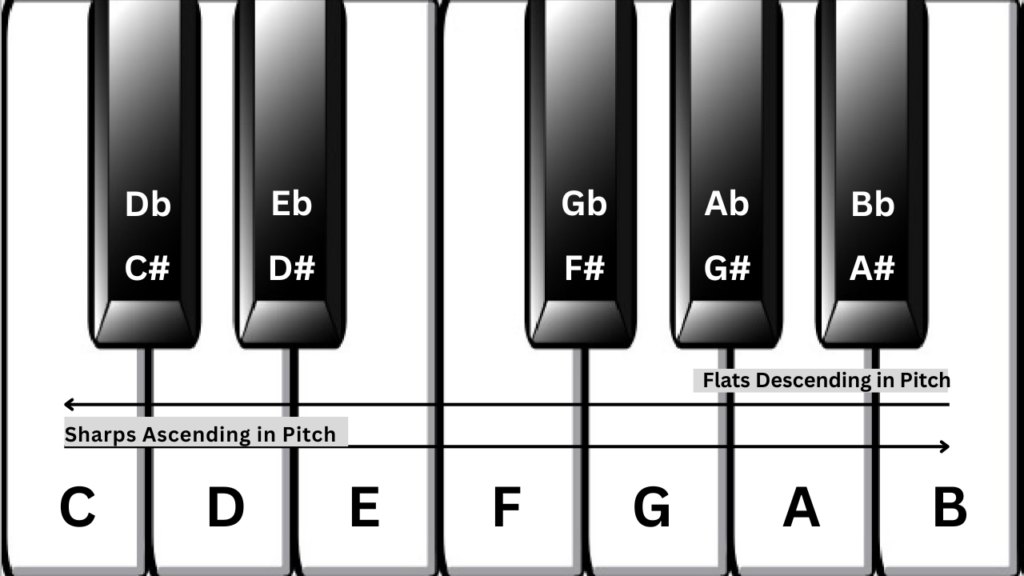
The key signature indicates which notes throughout a written piece of music are to be played as sharps or flats. This allows composers to write music notation without having to use individual sharps or flats on every accidental note.
Formal music notation includes a key signature to inform us of the key that a piece of music is to be played in. This is done by placing sharp or flat symbols directly after the treble and bass clef symbol. As shown in the illustration below, no sharp or flat symbols on the stave indicates the key signature of C major; one sharp symbol indicates the key of G major; two sharp symbols indicate the key of D major, etc. Similarly, one flat symbol indicates the key of F major; two flat symbols indicate the key of B♭ major, etc.
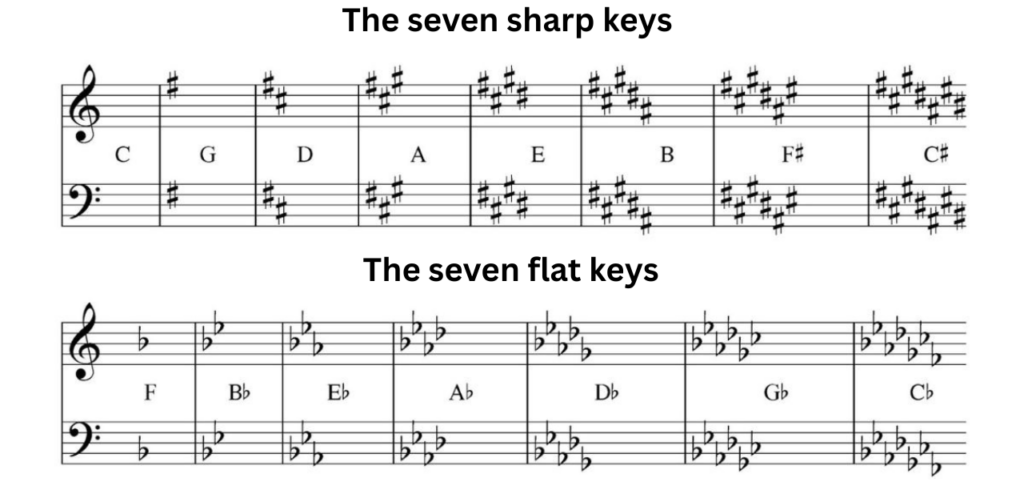
The Major Scale Interval Formula
The C Major scale adheres to an interval formula that allows us to move that scale shape on the guitar into other keys. “Interval” refers to the distance in pitch between two tones. For example, a whole-tone is two frets on the guitar (a whole step), whereas a semi-tone distance is only one fret (a half-step).
In order to better understand the Major scale interval formula let’s start by laying out the C Major scale in a linear fashion. Between each note (on the line above) I have placed a W or an H. The W represents a whole-tone (two fret) distance between the two pitches, while the H represents a half-tone (one fret) distance:
W W H W W W H
C D E F G A B C
As you can see, there is a half-tone distance of one fret between the third- and fourth-degree notes of E and F, and between the seventh- and eighth-degree notes of B and C. All the other interval distances are a whole-tone (two frets).
Once you understand this formula, you can start moving the C major scale into other keys. Here’s how:
Creating the Sharp Keys
The seven sharp keys can be easily built by simply shifting the starting point. For example, to create the key of G, simply start the C Major scale on the fifth degree (G) and use those notes to form the G Major Scale (with one caveat — see below), like this:
W W H W W W H
C D E F G A B C
W W H W W W W
G A B C D E F G
As you can see, there is a whole-tone interval between F and G, but the Major scale formula requires a half-tone interval. So in order to meet the pitch requirements, we need to raise the pitch of the F note to an F#:
W W H W W W H
C D E F G A B C
W W H W W W H
G A B C D E F# G
We can now see that the key of G major contains one sharpened tone F#, which is why you’ll find a single sharp symbol in the clef when musically notated.
You can continue the process to create the next sharp key by starting the G major scale on its fifth degree, the note D:
W W H W W W H
C D E F G A B C
W W H W W W H
G A B C D E F# G
W W H W W W H
D E F# G A B C# D
Once again, you have to raise the pitch of the C note to C# in order to retain the Major scale interval formula.
Similarly, you can build the next sharp key by starting on the fifth degree of D, the note A, to form the key of A major:
W W H W W W H
G A B C D E F# G
W W H W W W H
D E F# G A B C# D
W W H W W W H
A B C# D E F# G# A
As you can see, the C# and F# are retained from the key of D, while the G is sharpened to G# in order to retain the Major scale formula.
Keep going in the same way to create the other four sharp keys:
E Major = Four sharps (F#, G#, C#, D#)
B Major = Five sharps (F#, G#, C#, D#, A#)
F# Major = Six sharps (F#, G#, C#, D#, A#, E#)
C# Major = Seven sharps (F#, G#, C#, D#, A#, E#, B#)
Creating the Flat Keys
Just as there are seven sharp keys, there are seven flat keys. Here, we start each new key from the fourth degree of the previous scale, like this:
W W H W W W H
C D E F G A B C
W W H W W W H
F G A B♭ C D E F
This time, you have to flatten the B note to B♭ by a half-step to adhere to the Major scale interval formula. The resulting key of F therefore has one flat, B♭, which will be indicated by a single flat symbol in the stave when musically notated.
Now let’s create the next flat key:
W W H W W W H
C D E F G A B C
W W H W W W H
F G A B♭ C D E F
W W H W W W H
B♭ C D E♭ F G A B♭
This B♭ major scale is created by starting the F major scale on the fourth degree. The E needs to be lowered in pitch by a semi-tone to E♭ in order to follow the Major scale interval formula.
Simply continue the process to create the remaining five flat keys (E♭, A♭, D♭, G♭, C♭):
E♭ Major = Three flats (B♭, E♭, A♭)
A♭ Major = Four flats (B♭, E♭, A♭, D♭)
D♭ Major = Five flats (B♭, E♭, A♭, D♭, G♭)
G♭ Major = Six flats (B♭, E♭, A♭, D♭, G♭, C♭)
C♭ Major = Seven flats (B♭, E♭, A♭, D♭, G♭, C♭, D♭)
The Circle of Fifths and Circle of Fourths
When these key shifts are mapped out in a circular fashion instead, they form what are known as the Circle of Fifths and the Circle of Fourths, which looks like this:
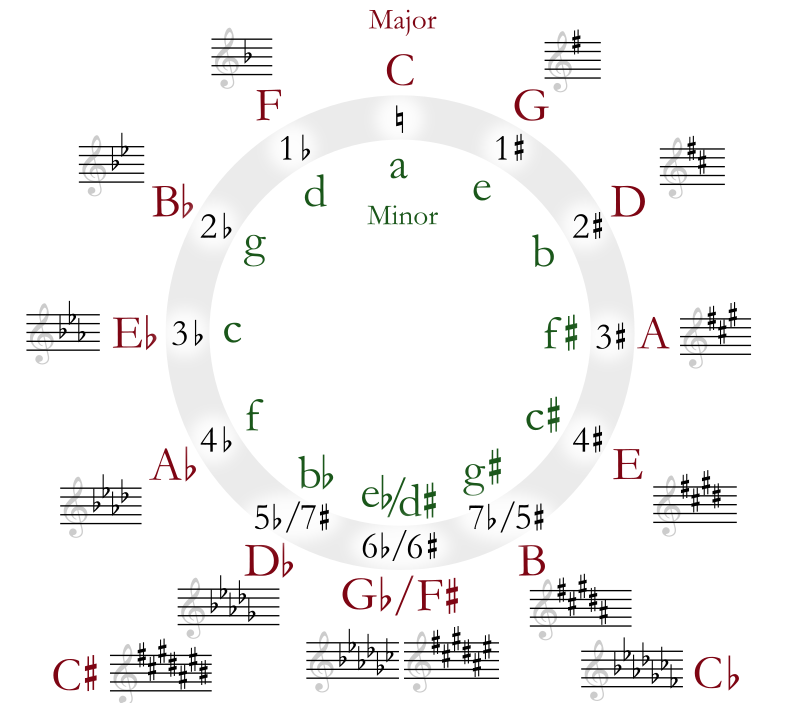
As you can see, the sharp keys (those keys that have one or more sharp symbols in the clef) are on the right side, while the flat keys (those that have one or more flat symbols) are on the left side. The sharp keys are created by moving in fifths clockwise from C natural, while the flat keys are created by moving in fourths counterclockwise from C natural.
Inside the circle are shown the relative minor keys —those that share the same key signature with their relative major keys.
If you’re wondering how we create 15 keys, when there are only 12 notes, that’s because three of the key signatures are enharmonic. In those keys (shown at the bottom of the circle), the musical pitches are the same, but they’ve been designated another name within the sharp or flat key signatures. The three enharmonic keys are:
C# / D♭
F# / G♭
B / C♭
The Video
This video features a solo I’m playing on a Yamaha Revstar RSE20. The bluesy, fat tone is coming from the humbucking neck pickup, processed slightly through a Line 6 Helix.
I’m playing the solo in the key of E major (which has four sharps) but using a lot of E major/C# minor pentatonic scale lines. Pentatonic scales are derived from the major scale, so they will also adhere to the key signature designations of the four sharps even though they only contain five notes. (D# is not present in the E major pentatonic scale, which consists of the notes E – F# – G# – B – C#.
By the way, if you’re curious as to why the solo sounds so laid back and relaxed, it’s because every one of the phrases starts on the downbeat of two. This leaves a nice amount of space between phrases. Try this approach next time you practice — I think you’ll like it.
The Guitar
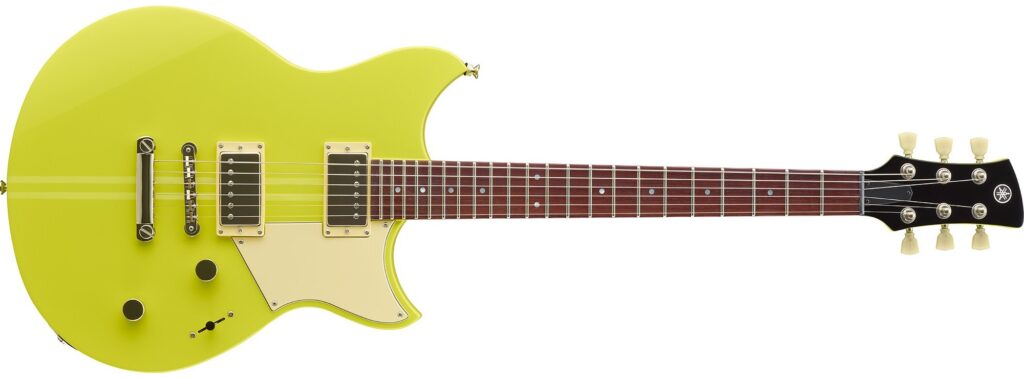
The Yamaha RSE20 electric guitar combines ultimate playability with world-class tonality. The jumbo frets, satin-finished neck and 24 3/4″ scale length make this guitar so easy to play! Fast lines are smooth, bending is slick, and the intonation is spot-on.
The two Alnico-V humbucking pickups are perfect for rock, pop and blues. The three main pickup selections can be further enhanced by pulling up on the tone control. This engages what Yamaha calls the “dry switch.” Think of this as a bass filter that reduces low frequencies to produce a cleaner, brighter version of the full humbucking sound.
This guitar is rock solid for travel too. Put an RSE20 in a gig bag along with an HX Stomp modeler, and you have a travel rig that weighs in at under 10 lbs.
The Wrap-Up
If you thought music theory wasn’t for you, I hope this posting helped to change your mind. The Circle of Fifths may seem a little intimidating at first, but it actually provides a very easy way to create the seven sharp keys used in music, just as the Circle of Fourths makes it easy to create the seven flat keys.
The bottom line is that the more knowledge you accumulate within the language of music, the broader your vocabulary becomes on guitar … or any musical instrument, for that matter.










